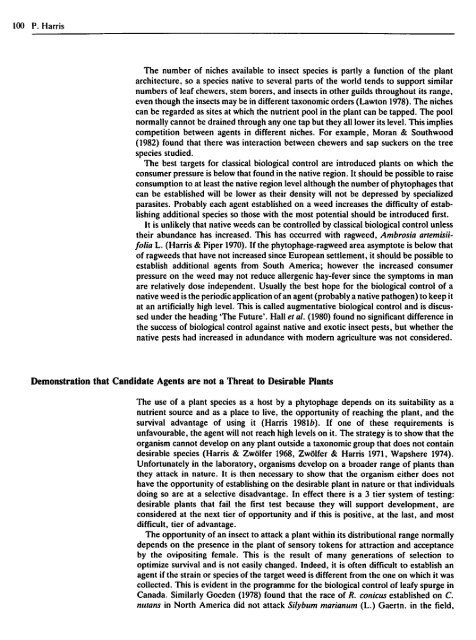pdf, 57.71Mb - Entomological Society of Canada
pdf, 57.71Mb - Entomological Society of Canada
pdf, 57.71Mb - Entomological Society of Canada
You also want an ePaper? Increase the reach of your titles
YUMPU automatically turns print PDFs into web optimized ePapers that Google loves.
100 P. Harris<br />
The number <strong>of</strong> niches available to insect species is partly a function <strong>of</strong> the plant<br />
architecture, so a species native to several parts <strong>of</strong> the world tends to support similar<br />
numbers <strong>of</strong> leaf chewers, stem borers, and insects in other guilds throughout its range,<br />
even though the insects may be in different taxonomic orders (Lawton 1978). The niches<br />
can be regarded as sites at which the nutrient pool in the plant can be tapped. The pool<br />
normally cannot be drained through anyone tap but they all lower its level. This implies<br />
competition between agents in different niches. For example, Moran & Southwood<br />
(1982) found that there was interaction between chewers and sap suckers on the tree<br />
species studied.<br />
The best targets for classical biological control are introduced plants on which the<br />
consumer pressure is below that found in the native region. It should be possible to raise<br />
consumption to at least the native region level although the number <strong>of</strong> phytophages that<br />
can be established will be lower as their density will not be depressed by specialized<br />
parasites. Probably each agent established on a weed increases the difficulty <strong>of</strong> establishing<br />
additional species so those with the most potential should be introduced first.<br />
It is unlikely that native weeds can be controlled by classical biological control unless<br />
their abundance has increased. This has occurred with ragweed, Ambrosia artemis;;folia<br />
L. (Harris & Piper 1970). If the phytophage-ragweed area asymptote is below that<br />
<strong>of</strong> ragweeds that have not increased since European settlement, it should be possible to<br />
establish additional agents from South America; however the increased consumer<br />
pressure on the weed may not reduce allergenic hay-fever since the symptoms in man<br />
are relatively dose independent. Usually the best hope for the biological control <strong>of</strong> a<br />
native weed is the periodic application <strong>of</strong> an agent (probably a native pathogen) to keep it<br />
at an artificially high level. This is called augmentative biological control and is discussed<br />
under the heading 'The Future'. Hall et al. (1980) found no significant difference in<br />
the success <strong>of</strong> biological control against native and exotic insect pests, but whether the<br />
native pests had increased in adundance with modem agriculture was not considered.<br />
Demonstration that Candidate Agents are not a Threat to Desirable Plants<br />
The use <strong>of</strong> a plant species as a host by a phytophage depends on its suitability as a<br />
nutrient source and as a place to live, the opportunity <strong>of</strong> reaching the plant, and the<br />
survival advantage <strong>of</strong> using it (Harris 1981b). If one <strong>of</strong> these requirements is<br />
unfavourable, the agent will not reach high levels on it. The strategy is to show that the<br />
organism cannot develop on any plant outside a taxonomic group that does not contain<br />
desirable species (Harris & Zwolfer 1968, Zwolfer & Harris 1971, Wapshere 1974).<br />
Unfortunately in the laboratory, organisms develop on a broader range <strong>of</strong> plants than<br />
they attack in nature. It is then necessary to show that the organism either does not<br />
have the opportunity <strong>of</strong> establishing on the desirable plant in nature or that individuals<br />
doing so are at a selective disadvantage. In effect there is a 3 tier system <strong>of</strong> testing:<br />
desirable plants that fail the first test because they will support development, are<br />
considered at the next tier <strong>of</strong> opportunity and if this is positive, at the last, and most<br />
difficult, tier <strong>of</strong> advantage.<br />
The opportunity <strong>of</strong> an insect to attack a plant within its distributional range normally<br />
depends on the presence in the plant <strong>of</strong> sensory tokens for attraction and acceptance<br />
by the ovipositing female. This is the result <strong>of</strong> many generations <strong>of</strong> selection to<br />
optimize survival and is not easily changed. Indeed, it is <strong>of</strong>ten difficult to establish an<br />
agent if the strain or species <strong>of</strong> the target weed is different from the one on which it was<br />
collected. This is evident in the programme for the biological control <strong>of</strong> leafy spurge in<br />
<strong>Canada</strong>. Similarly Goeden (1978) found that the race <strong>of</strong> R. conicus established on C.<br />
nutans in North America did not attack Silybum marianum (L.) Gaertn. in the field,
















